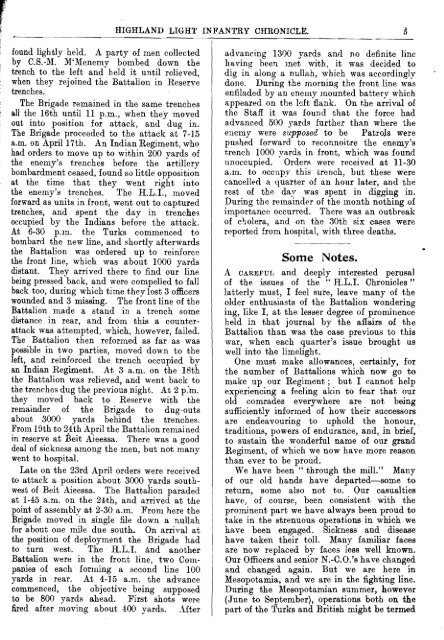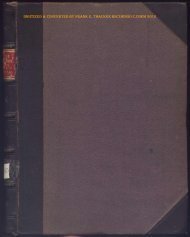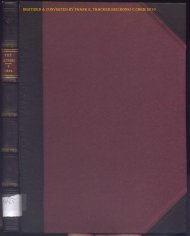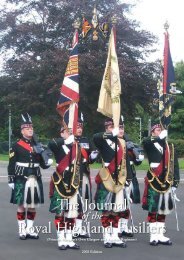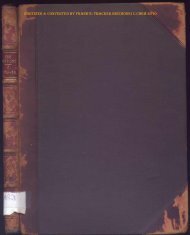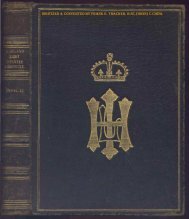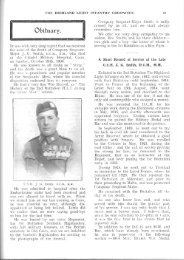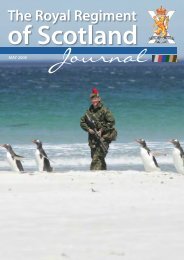HLI Chronicle 1917 - The Royal Highland Fusiliers
HLI Chronicle 1917 - The Royal Highland Fusiliers
HLI Chronicle 1917 - The Royal Highland Fusiliers
Create successful ePaper yourself
Turn your PDF publications into a flip-book with our unique Google optimized e-Paper software.
found lightly held. A party of men collected<br />
by C.S.-1\1. M'Menemy bombed down the<br />
trench to the left and held it until relieved,<br />
when they rejoined the Battalion in Reserve<br />
trenches.<br />
<strong>The</strong> Brigade remained in the same trenches<br />
all the 16th until 11 p.m., when they moved<br />
out into position for attack, and dug in.<br />
<strong>The</strong> Brigade proceeded to the attack at 7-15<br />
a.m. on April 17th. An Indian Regiment, who<br />
had orders to move up to within 200 yards of<br />
the enemy's trenches before the artillery<br />
bombardment ceased, found so little opposition<br />
at the time that they went right into<br />
the enemy's trenches. <strong>The</strong> H.L.I., moved<br />
forward as units in front, went out to captured<br />
trenches, and spent the day in trenches<br />
occupied by the Indians before the attack.<br />
At 6-30 p.m. the Turks commenced to<br />
bombard the new line, and shortly afterwards<br />
the Battalion was ordered up to reinforce<br />
the front line, which was about 1000 yards<br />
distant. <strong>The</strong>y arrived there to find our line<br />
being pressed back, and were compelled to fall<br />
back too, during which time they lost 3 officers<br />
wounded and 3 missing. <strong>The</strong> front line of the<br />
Battalion made a stand in a trench some<br />
distance in rear, and from this a counterattack<br />
was attempted, which, however, failed.<br />
<strong>The</strong> Battalion then reformed as far as was<br />
possible in two parties, moved down to the<br />
left, and reinforced the trench occupied by<br />
an Indian Regiment. At 3 a.m. on the 18th<br />
the Battalion was relieved, and went back to<br />
the trenches dug the previous night. At 2 p:m.<br />
they moved back to Reserve with the<br />
remainder of the Brigade to dug-outs<br />
about 3000 yards behind the trenches.<br />
From 19th to 2.4th April the Battalion remained<br />
in reserve at Beit Aieessa. <strong>The</strong>re was a good<br />
deal of sickness among the men, but not many<br />
went to hospital.<br />
Late on the 23rd April orders were received<br />
to attack a position about 3000 yards southwest<br />
of Beit Aieessa. <strong>The</strong> Battalion paraded<br />
at 1-45 a.m. on the 24th, and arrived at the<br />
point of assembly at 2-30 a.m. From here the<br />
Brigade moved in single file down a nullah<br />
for about one mile due south. On arrival at<br />
the position of deployment the Brigade had<br />
to turn west. <strong>The</strong> H.L. I. and another<br />
Battalion were in the front line, two Companies<br />
of each forming a second line 100<br />
yards in rear. At 4-15 a.m. the advance<br />
commenced, the objective being supposed<br />
to be 800 yards ahead. First shots were<br />
fired after moving about 400 yards. After<br />
aIGHLAND LIGHt INFANTRY CHRONIdLE.<br />
ad\Tancing 1300 yards and no definite line<br />
baving been met with, it was decided to<br />
dig in:- along a nullah, which was accordingly<br />
done. During the morning the front line was<br />
enfiladed by an enemy mounted battery which<br />
appeared on the left flank. On t,he arrival of<br />
the Staff it was found that the force had<br />
advanced 500 yards further than where the<br />
enemy were supposed to be Patrols were<br />
pushed forward to reconnoitre the enemy's<br />
trench 1000 vards in front. which was found<br />
unoccupied.. Order" were· received at 11-30<br />
a.m. to occupy this trench, but these were<br />
cancelled a quarter of an hour later, and the<br />
rest of the day was spent in digging in.<br />
During the remaind('r of the month nothing of<br />
importance occurred. <strong>The</strong>re was an outbreak<br />
of cholera, and on the .30th six cases were<br />
reported from hospital, with three deaths.<br />
Some Notes.<br />
A CAREFUL and deeply interested perusal<br />
of the issues of the "H.L.I. <strong>Chronicle</strong>s"<br />
latterly must, I feel sure, leave many of the<br />
older enthusiasts of the Battalion wondering<br />
ing, like I, at the lesser degree of prominence<br />
held in that journal by the affairs of the<br />
Battalion than was the case previous to this<br />
war, when each quarter's issue brought us<br />
well into the limelight.<br />
One must make allowances, certainly, for<br />
the number of Battalions which now go to<br />
make up our Regiment; but I cannot help<br />
experiencing a feeling akin to fear that our<br />
old comrades everywhere are not being<br />
sufficiently informed of how their successors<br />
are endeavouring to uphold the honour,<br />
traditions, powers of endurance, and, in brief,<br />
to sustain the wonderful name of our grand<br />
Regiment, of which we now have more reason<br />
than ever to be proud.<br />
We have been" through the mill." :Many<br />
of our old hands have departed-some to<br />
return, some also not to. Our casualties<br />
have, of course, been consistent with the<br />
prominent part we have always been proud to<br />
take in the strenuous operations in which we<br />
have been engaged. Sickness and disease<br />
have taken their toll. Many familiar faces<br />
are now replaced by faces less well known.<br />
Our Officers and senior N.-C.O.'s have changed<br />
and changed again. But we are here in<br />
Mesopotamia, and we are in the fighting line.<br />
During the Mesopotamian summer, however<br />
(June to September), operations both on the<br />
part of the Turks and British might be termed


